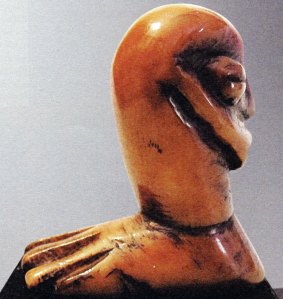My father was a collector. He was fascinated by the shapes, the patina and the strong and subtle power of African art. He left for the spirit world in September, leaving my mother and I the legacy of his collection and memories.
The collection will go to auction. My mother and I are busy shaping the event into a tribute to the man and his work as a collector, researcher and thinker. It is in the context of this tribute that the ‘Twisted Foot’ project was born: one of the pieces my father held on to is small and quite special. Before it leaves the house for good, I wish to give it another life and I hand it to different artists for their visual and verbal interpretations. And who knows, maybe something else…
The foot – because that’s what it is – was carved by the Lega people from the Democratic Republic of the Congo. They had a special relationship towards objects, their symbolic nature and art. The Lega has a social structure based on three pillars: kinship (the importance of both paternal and maternal filiation), circumcision (allowing boys to enter adulthood) and the Bwami brotherhood, whose primary objective is to instill ‘wisdom and moral perfection’ in its initiates (L’Art des Lega, Quai Branly, 2013, page 45). The Lega people cannot choose their family or their clan, but they can choose whether or not to climb the rungs of the initiatory brotherhood. The Bwami brotherhood is accessible to men as well as women, provided they are married. The progression of either member of a couple is dependent on that of the other. Initiation ceremonies are complex and include a part where candidates are presented with an object for learning and/or as a source of reflection. The higher the rank (of which there are five), the more sophisticated and beautiful the object. “Lega art is an expression of sacredness.” (Muyololo, ibid., page 63). “To the non-initiated, the objects were ‘deliberately vague, nebulous and ambiguous’, helping to preserve their strength within the Bwami” (ibid., page 62). “By associating the initiatory objects with body language, drama, the song of music, and proverbs, the master transforms them into a new visual vocabulary. He combines the latter with other vocabulary to create new metaphors. Each object therefore carries a number of different meanings depending upon the context in which it is used” (ibid., page 62).
Nothing is known about this foot. It is 7 cm high and made out of ivory. It is not known whether the object was used as part of a ceremony but, given the context, we can easily assume that it was. Looking at its form, one might think of a sort of aporia, a problem with no logical solution. It makes me think of a koan – paradoxes used by Zen monks in their training, to let go of their dependence on reason and force them to attain enlightenment through intuition. An impossibility. A sphinx. Janus. Head versus heel. A twisted foot…
Anne
